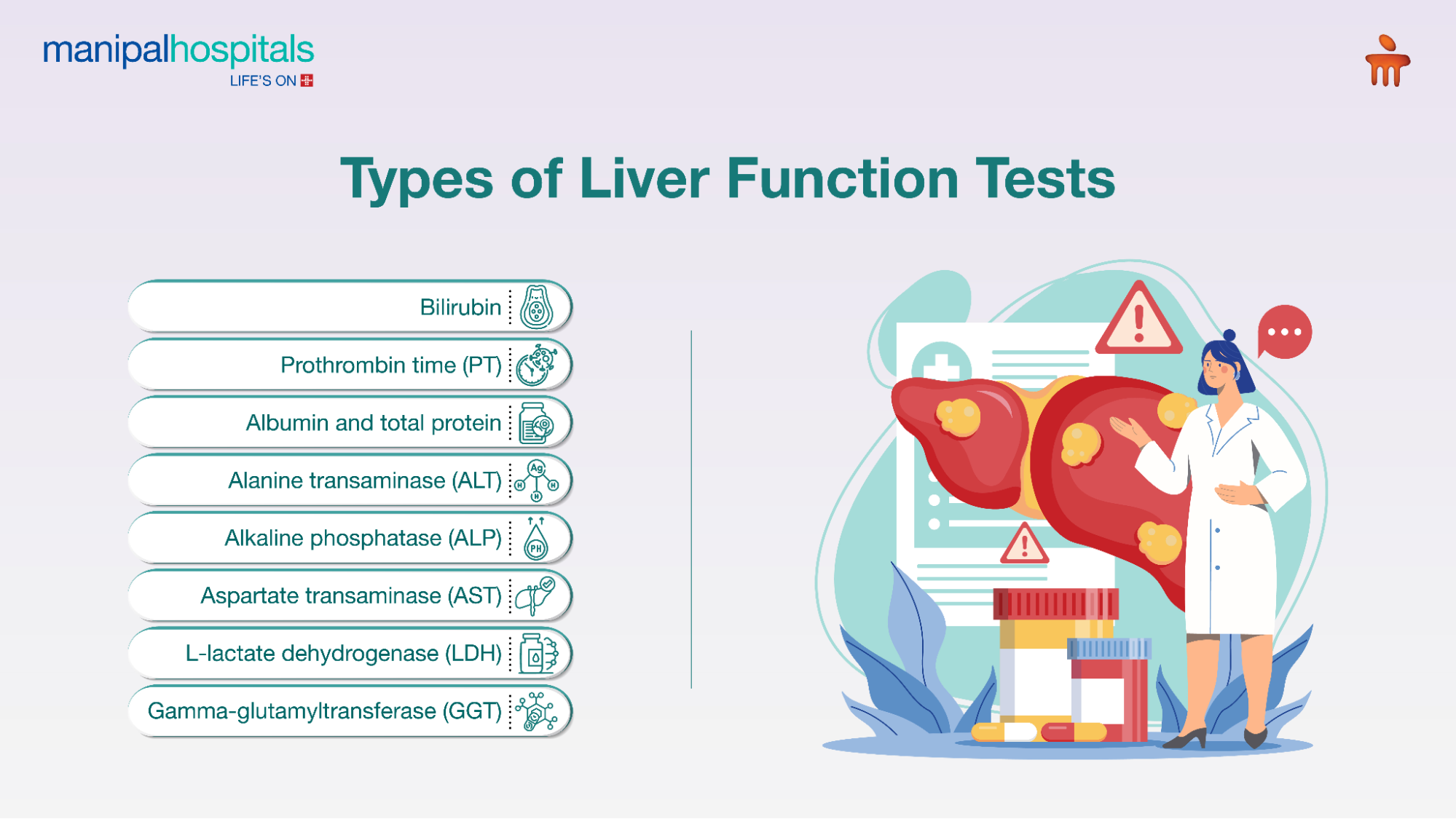
In India, liver disease has become the 11th leading cause of death, with over 2 million deaths annually, accounting for 4% of all deaths — that is, 1 in every 25 deaths worldwide. The mortality rate due to chronic liver diseases is seeing an upward trend. Diagnosing and treating liver diseases early can help increase survival rates. Thus, liver function tests are the most commonly used laboratory tests to assess the functioning of the liver and its overall health. This test measures various substances produced by the liver, giving insights into liver health, making it crucial to undergo this test periodically. This blog will help you understand what is a liver function test is, why it is done, how the liver test is done, and the interpretation of results.
Synopsis
What is a Liver Function Test?
Liver function tests (LFTs) are blood tests used to measure proteins, enzymes, and bilirubin, as well as to check for infections, adverse effects of medications, the severity of liver damage, and chronic conditions. The levels of these substances help assess the liver's overall health. Any abnormal elevation or reduction in these values may indicate liver dysfunction, allowing for early detection of potential liver damage or disease.
A liver function blood test can measure several important substances, such as proteins, enzymes, bilirubin, and other byproducts. LFT, or a liver panel test, detects, monitors, and assesses various liver-related conditions.
Why is a Liver Function Test Done?
A liver function test may be recommended for the following reasons:
● Screening for various liver diseases or infections such as hepatitis, cirrhosis, fatty liver disease, and liver cancer.
● Monitoring liver health, progression of liver disease, and assessing the effectiveness of the treatment.
● Recognising and evaluating symptoms of diseases to determine their relation to liver dysfunction.
● Assessing the severity of liver damage due to side effects of medications or other reasons helps guide treatment decisions and ensure that the liver remains healthy.
● Monitoring overall health, as LFT values help in finding liver issues that may not show symptoms in early stages.
● Early signs of liver damage can be assessed in high-risk patients undergoing regular LFTs.
● For a pre-surgery evaluation to assess liver health before undergoing major surgeries, which helps in avoiding post-surgical complications.
Types of Liver Function Tests
Various tests fall under the category of liver function tests. The elevation in these tests gives an insight into the different aspects of liver health. The most common LFT tests are:

-
Alanine transaminase (ALT): ALT is an enzyme found in the liver that helps convert proteins into energy. Elevated levels indicate liver damage, and they are also referred to as the SGPT test.
-
Aspartate transaminase (AST): This enzyme helps break down amino acids, and high AST levels may indicate liver disease, liver damage, or muscle damage. It is also sometimes referred to as the SGOT test.
-
Alkaline phosphatase (ALP): This enzyme is found in the liver, bones and other tissue and is responsible for breaking down proteins. Its higher level can indicate liver damage, disease related to the blockage of the bile duct or bone diseases.
-
Albumin and total protein: Albumin is a protein produced in the liver. These proteins are needed to fight infections and for other functions. The low levels of albumin and total protein may suggest liver damage or a disease related to the liver, kidney, or gastrointestinal system.
-
Bilirubin: This substance is a waste product produced from the breakdown of red blood cells. It then passes through the liver and is expelled from the body through the stool. High levels could indicate liver damage or disease.
-
Gamma-glutamyltransferase (GGT): This enzyme is found in the blood. Higher levels mean liver or bile duct damage, but it's a non-specific test, as elevated levels can also be seen in other conditions.
-
Prothrombin time (PT): This test indicates how long it takes your blood to form a clot. Increased PT time may suggest liver damage, as the liver produces clotting factors.
-
L-lactate dehydrogenase (LDH): This enzyme is found in the liver and other body tissues. Higher levels could indicate liver damage.
How is a Liver Function Test Done?
If you're wondering how to do a liver function test, it is a simple and quick blood test in which a blood sample is collected from a vein in your arm and sent to the laboratory for further testing. The procedure is generally painless except for a slight discomfort during the needle insertion.
Interpretation of Results
|
Test |
Normal range |
|
Alanine transaminase (ALT) |
0-40 IU/L |
|
Aspartate transaminase (AST) |
0-35 IU/L |
|
Alkaline phosphatase (ALP) |
30-120 IU/L |
|
Gamma-glutamyltransferase (GGT) |
0-30 IU/L |
|
Bilirubin |
0.1 to 1.2 mg/dL |
|
Prothrombin time (PT) |
10.9-12.5 sec |
|
Albumin and total protein |
3.5 to 5.0 g/dL |
|
Total proteins |
3-0.8 g/dL |
To interpret the results of liver function tests, it's important to first know the normal ranges of the liver substances and enzymes to determine the elevation or decline. The range differs among sexes, adults, and children, body sizes, and different laboratories. The normal average ranges are2:
● ALT: 0-45 IU/L
● AST: 0-35 IU/L
● ALP: 30-120 IU/L
● GGT: 0-30 IU/L
● Bilirubin: 2-17 micromoles/L
● PT: 10.9-12.5 seconds
● Albumin: 40-60 g/L
● Total proteins: 3-0.8 g/dL
The deviation in the levels indicates whether there is liver damage, liver injury, alcohol-induced injury, fatty liver disease, viral hepatitis, Wilson’s disease, toxic hepatitis, autoimmune hepatitis, cirrhosis, liver cancer, etc. The liver function test may not be sufficient alone to diagnose these conditions; hence, additional tests, imaging, or a Biospy may be needed for further evaluation.
If you already have liver disease, liver function tests can help your doctor monitor the progress of the treatment and assist in deciding the further course of action.
Conclusion
Liver function tests are critical tools for assessing the health and function of the liver. By understanding what is liver function test is, its purpose, types of LFT tests, as well as the interpretation of the results, you can manage your liver health better. If your LFT results are abnormal, consult a Medical Gastroenterologist at KMC Hospital, who can provide appropriate treatment options and lifestyle recommendations based on your condition. Regular monitoring and early detection can help in preventing and managing liver-related issues effectively.
FAQ's
Look for these signs and symptoms to rule out liver disease. These include belly pain or swelling, jaundice (yellowing of skin or eyes), leg or ankle swelling, pale stool, dark urine, itchy skin, fatigue, easy bruising, and loss of appetite.
The most commonly conducted liver function tests include assessing the liver enzymes, such as alkaline phosphatase (ALP), alanine transaminase (ALT), gamma-glutamyl transferase (GGT) and aspartate aminotransferase (AST).
Fasting (abstaining from food and drink, except water) for 10–12 hours is generally recommended before undergoing the test. Some medications can interfere with the liver test results, so it's important to inform your doctor about all the medications you are taking, but do not stop taking them unless advised by your doctor.
A routine liver function test can indicate fatty liver through the levels of the ALT enzyme. Alanine aminotransferase (ALT) enzyme is a marker for liver inflammation; thus, its higher levels indicate fatty liver.
Liver function tests are generally safe. They may cause minor complications like bleeding or discomfort at the blood draw site.





















 5 Min Read
5 Min Read



















